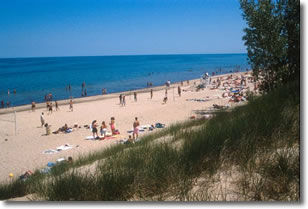
A summer day at a beach along the Indiana shoreline of Lake Michigan. But is it safe to go in the water? Using the current standard procedure for deciding on whether to keep a beach open, we don't really know.
Beaches along the Lake Michigan shoreline from Milwaukee, Wisconsin, to Michigan City, Indiana, have long been plagued by occurrences of high Escherichia coli (E. coli) concentrations in the water. Most health officials and beach managers have a policy of closing the beaches to swimming whenever E. coli concentrations are above the United States Environmental Protection Agency (USEPA) recommended limit of 235 colony forming units (cfu) per 100 milliliters (mL). A major problem facing decision makers is that E. coli analyses generally take 24 hours to complete, so swimming bans are based on day-old information. Retrospective inspections have shown that there have been numerous instances when beaches were closed when they could have remained open or left open when they should have been closed. Any relationship that might exist between beach water quality on the day of sampling and on the day of decision is rarely known.
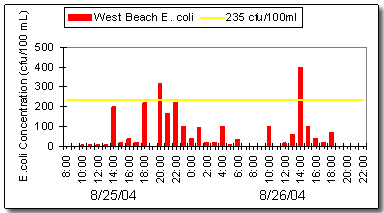
Measured E. coli at Indiana Dunes State Park Beach, West End Beach.
The graph to the left shows the E. coli concentrations for two days in August 2004. When the E. coli concentration (red bars) was greater than 235 cfu/100mL (yellow line), the swimming beach should have been closed for public safety. Because no rapid and accurate method for measuring E. coli concentrations has yet been developed, indirect methods may show the most promise for improving the accuracy of beach-closure decisions. We are developing a methodology for making forecasts of beach-water quality on the basis of hydrometeorological conditions.
Developing “SwimCasts”
Understanding and predicting short-term variability of bacteria concentrations
in stream water and lake water is crucial to the development of an early
warning system for beach closures along the Indiana shoreline of Lake
Michigan. This study was designed to evaluate the variability of E.
coli concentrations in water discharging from Dunes Creek onto the
main swimming beach at Indiana Dunes State Park and to develop a predictive
model that relates the outfalls of creek water, as well as other hydrometeorological
factors, to concentrations of E. coli bacteria in the beach's
swimming zone.
The goal of this project was to develop prototypical statistical models for predicting the need for beach closures and openings. The approach used, called “swimcast” by Mark Pfister of the Lake County Illinois Health Department, involves (1) installing electronic sensors for continuous monitoring of hydrometeorological conditions (rainfall, sunshine, winds, waves, and so on) at the beach of concern; (2) developing statistical (regression) equations that correlate measured E. coli concentrations to the hydrometeorological variables; and (3) posting warnings and closures based on the results of the statistical regression (predictive) equation output. Such an approach allows decisions to be made hourly in real time so that beaches can be closed when the probability of high E. coli concentrations is great, and then re-opened when the risk to health has abated.
The approach described above was originally developed for the City of Chicago during the summer of 2000. The results of that effort were very promising (Olyphant and Whitman, 2004). However, the methodology must be tested at other beaches around Lake Michigan (and elsewhere) before it is adopted by beach managers and other decision makers responsible for protecting the health of the millions of people who visit public beaches each summer.
Study Site
We conducted the project in northwestern Indiana (Porter County) at the
main beach of the Indiana Dunes State Park—Indiana Dunes State Park
Beach, West End and East End. Dunes Creek enters Lake Michigan between
two swimming sections of this beach. This beach was chosen because it
is a very popular tourist beach and because it has a long history of water-quality
problems. Dunes Creek, which is commonly laden with high concentrations
of bacteria, discharges water from a 30 km2 (11.58 mi2)
drainage area directly into the lake at the beach. Monitoring stations
were installed to monitor lake water, meteorological conditions, and stream-flow
conditions. See the map below for locations of monitoring points.
Developing a Predictive Model

Location map showing instrumentation and sampling locations on Dunes Creek Beach, East End Beach and West End Beach.

Indiana Dunes State Park, with bacterial plume entering Lake Michigan from Dunes Creek.
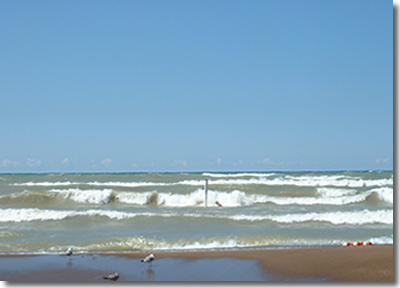
Waves in Lake Michigan, which have been found to be related to bacteria levels in the water.
For many years, scientists and beach managers have recognized that high concentrations of E. coli in water adjacent to swimming beaches along the Lake Michigan shoreline occur after storms. There are at least two reasons for this. In some instances, large rainstorms in developed areas near the coast produce excess runoff that can overwhelm sewage treatment plants and cause failure of on-site septic systems. The resulting outflows of sewage enter the local drainage systems and eventually discharge into the lake and load it with bacteria for several hours at rates exceeding 106 cfu/100mL per second (Olyphant and others, 2003). Once the bacteria have entered the lake, currents may push the contaminated water toward a beach and make it unhealthy for swimming. Secondly, studies at beaches along the southern shore of Lake Michigan have also shown that E. coli concentrations in the sands of the swash zone are high, or higher, than those of the water (Whitman and others, 1999). When storm winds initiate waves and direct them onto the beaches, the foreshore sand is eroded and “stored” bacteria are released into the water, raising the E. coli concentrations to levels that are above the allowable threshold for full body contact (Whitman and others, 1999; Haack and others, 2002). Of course, there are other factors that can strongly influence the bacterial concentration of beach water. For example, E. coli are very sensitive to sunlight (especially ultraviolet light), which causes them to deactivate (Fujioka and others, 1981; Davis-Colley and others, 1994).
With these facts in mind, a multivariate model was developed for predicting E. coli-concentrations in the swimming zone of Lake Michigan beaches. The model used local (site-specific) data on wind speed and direction, rainfall, temperature, and incoming solar radiation, as well as data on water temperature, waves, turbidity and other selected water-quality variables, to predict the concentration of E. coli bacteria in the swimming zone of a particular beach. Although the ultimate aim is to develop site-specific models for all Lake Michigan beaches, the initial effort focused on the beaches at Indiana Dunes State Park.
The table below lists all of the hydrometeorological variables
that were used in the statistical regression analyses at West End Beach.
| Variable Considered |
Symbol
|
Units
|
Measurement
Interval
|
|---|---|---|---|
| Rainfall (1-hour, 4-hour, 12-hour, 24-hour totals) |
R
|
cm
|
#
*24hr
|
| Onshore component of wind (1-hour, 4-hour averages) |
Wvn
|
m/s
|
#
*1 hr
|
| Alongshore component of wind (1-hour, 4-hour averages) |
Wvp
|
m/s
|
#
*1 hr
|
| Wave height (1-hour, 4-hour averages) |
Hw
|
cm
|
#
*1 hr
|
| Lake stage (1-hour, 4-hour averages) |
S
|
cm
|
#
|
| Solar insolation (1-hour, 4-hour averages) |
If
|
---
|
#
*1 hr
|
| Air temperature (1-hour, 4-hour averages) |
Ta
|
C
|
#
*1 hr
|
| Water temperature (1-hour, 4-hour averages) |
Tw
|
C
|
#
|
| Water turbidity (1-hour, 4-hour averages) |
τ
|
NTU
|
#
|
| Stream discharge (1-hour average) |
Q
|
L/s
|
---
|
| E. coli loading by stream flow (1-hour average) |
EL
|
cfu/s
|
#
*1 hr
|
| Binary indicator of sample collection time |
MA
|
1/0
|
#
|
* variable contributed significantly to the predictive (regression) equation
The predictive models developed in this study are based on time-series regression analysis. Models were developed for two swimming beaches as well as Dunes Creek; however, only the model developed for Indiana Dunes State Park Beach,West End (West End Beach) is presented here as an example. All of the variables listed in the previous table, as well as their products (representing statistical interactions), were considered as potentially predictive variables. However, only those variables and interactions that contributed significantly to the regression, as represented by a statistical test of their associated regression coefficients, are discussed below.
Predictive Equation: Indiana Dunes State Park Beach, West End
ln ECt = b0 + b1 Hwt + b2 Wvpt + b3 ln ELt + b4 Hwt * R24 * Wvnt + b5 MA * Tat * Ift + ρ * et-1 + νt ,
where EC is the predicted E. coli concentration; ρ is the autocorrelation coefficient; e is the correlated error; ν is the random error of the predicted value; and bx represent multiple correlation coefficients. All other variables in the predictive equation are defined in the table above.
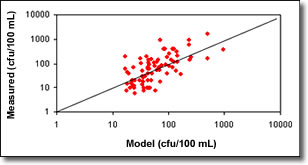
Graph showing performance of predictive model.
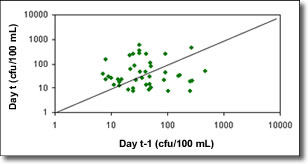
Traditional method of closing beaches based on day-old information
In the case of West End Beach, the performance of the predictive equation was evaluated by comparing model predictions of when the E. coli concentration would be above or below 235 cfu/100 mL with measured concentrations in samples of beach water. Realizing that there are errors associated with both the model and the actual sampling method, a 99-percent confidence interval was placed on each model prediction (namely, there is a 99 percent probability that the real value lies between the upper and lower bounds of the predicted value range). The model-based predictions can also be compared with the traditional method of assessing the need for beach closure, which is to evaluate the bacterial contamination level of the previous day's field samples.
The regression model predicted measured E. coli concentration (EC) (R = 0.63; left graph above) much more accurately than samples collected the previous day (R = 0.02; right graph above). The regression-model predictions of whether the E. coli concentration was above or below the 235 cfu/100mL threshold matched those of the field sampling on 69 out of 81 cases, indicating 85 percent accuracy. However, given the uncertainty associated with both the model and the field sampling, it is useful to put a 99-percent confidence interval on the predictions. When this was done, only four cases remained unaccounted for (all of which yielded underpredictions); this implies that the model will provide a degree of accuracy about 95 percent of the time.
Discussion of Model Results
The model results (statistical regression equations) indicate that water-quality
conditions (E. coli outfalls and concentrations) can be successfully
predicted using output from electronic sensors that have been programmed
to collect data on a continuous basis (namely, in real time). The best-fit
regression model developed for the West End Beach is complex. Primary
controls on the E. coli concentration are wind, waves, rain,
sun, and the contribution of E. coli from Dunes Creek. The bacterial
outflow from Dunes Creek is statistically significant, but not a dominant
factor. There is a significant effect of the parallel wind vector, indicating
that winds from the east blow the discharge plume towards the West End
Beach and increase its E. coli concentration. Waves have a very
significant effect on E. coli concentrations at the West End
Beach, and they also seem to interact with onshore winds (normal component
wind vector) and rainfall to affect the water quality. The West End Beach
also exhibits interactions of time of day (morning or afternoon), sunshine,
and temperature, but the effect is one of increasing the E. coli concentration. Taken together, this increase in bacterial levels may simply
be an artifact of more swimmers in the water (stirring up sediment and
directly adding to the lake water pollution), or it may be indicating
that some kind of bacterial population growth is occurring at the beach
under the warm sunny conditions.
Conclusions
-
Predicting the need for closures and (or) the issuing of health warnings cannot be reliably achieved using the concentration of bacteria in the water column in samples collected the previous day. This is certainly true for the beaches at Indiana Dunes State Park, but also is probably true for most beaches along the entire shoreline of Lake Michigan.
-
Predictive models based on continuously measured hydrometeorological variables — SwimCasts — provide a better alternative to once-daily sampling because they have been demonstrated to be more accurate and can be revised on an as-needed basis. All such model-based forecasts have uncertainty associated with them and should be based on probabilities. For example, using a 99-percent confidence interval at the West End Beach in this study, the model provided a degree of accuracy about 95 percent of the time.
-
Many beaches are not dominated by a river outfall, and water quality in the swimming zone is strongly influenced by prevailing weather conditions including rainfall, sunshine, temperature, winds, and waves. The bacterial concentrations in these beaches have a very short “memory” (namely, the bacterial concentrations don't behave predictably over successive time intervals). The West End Beach seems to be of this type except when easterly winds push the contaminant plume of the Dunes Creek outfall updrift toward the beach.
-
Beaches that are immediately downdrift of a bacterially infested stream, such as East End Beach, show strong dependence on the outfall of bacteria during storms and the high resulting concentrations can persist for a long time.
-
Beaches that are very close to one another, such as the West End Beach and East End Beach, do not necessarily respond in the same way to prevailing conditions. For this reason, caution should be exercised when trying to generalize the results of one beach study/model to other beaches, even when they are in close proximity.
Additional Resources
- Indiana Department of Natural Resources, Lake Michigan Coastal Program -
http://www.in.gov/dnr/lakemich/ - Great Lakes Information Network -
http://www.great-lakes.net/ - Save the Dunes Council -
http://www.savedunes.org/ - Indiana Department of Environmental Management, Lake Michigan Beaches -
http://www.in.gov/idem/beaches/ - Environmental Protection Agency, Great Lakes Program Office -
http://www.epa.gov/glnpo/michigan.html - Indiana Dunes National Lakeshore -
http://www.nps.gov/indu/index.htm - Center for Disease Control, Swimming in Healthy Waters -
http://www.cdc.gov/healthyswimming/
References Cited
Davis-Colley, R. J., Bell, R. G., and Donnison, A. M., 1994, Sunlight inactivation of Enterococci and fecal coliform in sewage effluent diluted in seawater: Applied and Environmental Microbiology, v. 60, p. 2,049-2,058.
Fujioka, R. S., Hashimoto, H. H., Siwak, E. B., and Young, R. H. F., 1981, Effect of sunlight on survival of indicator bacteria in seawater: Applied and Environmental Microbiology, v. 41, p. 690-696.
Haack, S. K., Fogarty, L. R., and Wright, C., 2002, Environmental influences on numbers of E. coli and Enterococci in beach water, Grand Traverse Bay, Michigan: 2002 Great Lakes Beach Conference, Chicago, Illinois.
Olyphant, G. A., Thomas, J., Whitman, R. L., and Harper, D., 2003, Characterization and statistical modeling of bacterial (Escherichia coli) outflows from watersheds that discharge into southern Lake Michigan: Environmental Monitoring and Assessment, Special Issue on Environmental Monitoring and Assessment Program Symposium 2001, Coastal Monitoring through Partnerships, v. 81, p. 289-300.
Olyphant, G. A., and Whitman, R. L., 2004, Elements of a predictive model for determining beach closures on a real time basis—the case of 63rd Street Beach, Chicago: Environmental Monitoring and Assessment, v. 98, p. 175-190.
Whitman, R. L., Becker-Nevers,
M., and Gerovac, P. J., 1999, Interaction of ambient conditions and fecal
coliform bacteria in Southern Lake Michigan beach waters: Monitoring Program
Implications, Natural Areas Journal, v. 19, p. 166-171.


